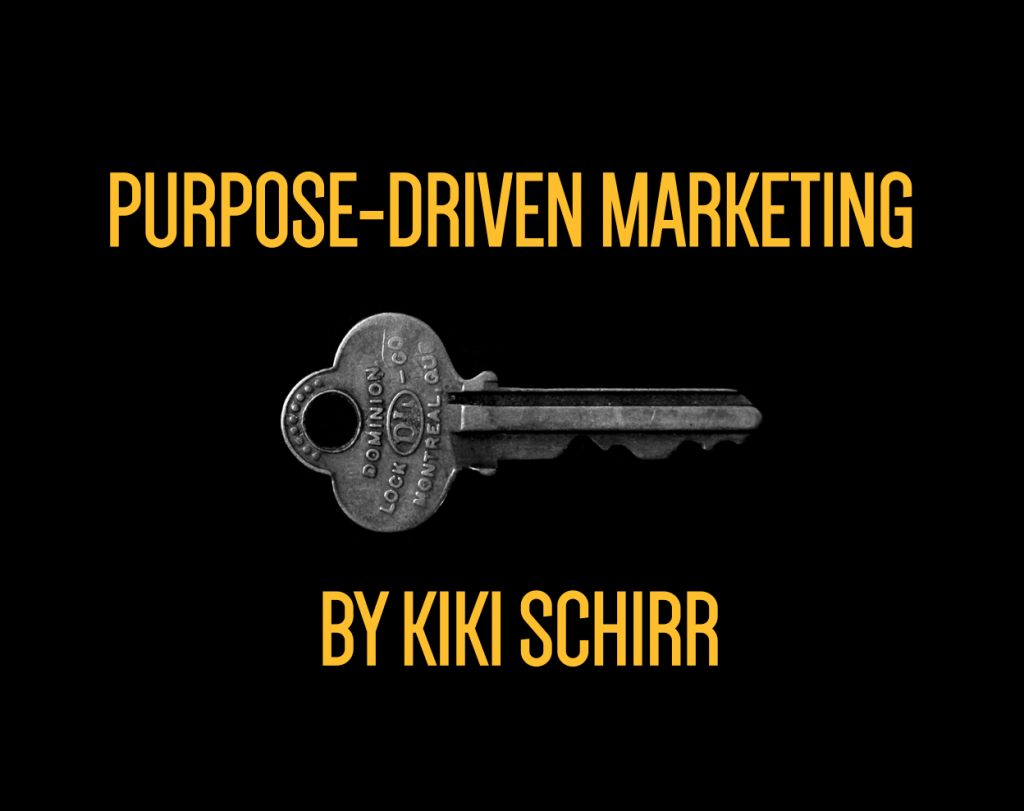By Kiki Schirr, {grow} Contributing Columnist
You’ve heard that Toms gives away the shoes it sells, that Warby Parker donates glasses to children in need, and that KIND bars sponsor, well, kindness. All of these companies are united by their strong commitment to their purpose but they’re also united by success.
In an age where even Pepsi is attempting to jump on the social good train with Naked Juice’s #DrinkGoodDoGood campaign, it’s becoming clear: purpose-driven marketing is vital to your success.
Purpose-driven marketing by the numbers
Even if a company doesn’t actively give charitable donations having a clear and well-communicated sense of purpose can help steer it in the right direction. A recent study by Ey Beacon Institute and Harvard Business Review looked into the performance of companies over a 3-year period in light of how well they communicated their company’s purpose.
The study divided the participating companies into three groups: “Prioritizers,” who had clearly stated and widely spread purposes; “Developers,” who had not communicated their purpose to everyone; and “Laggards,” who were doing a poor job of communicating their values.
For “Laggards,” 42% of companies saw stagnation or a decrease in growth. Only 42% saw a growth of 10% or more.
Of companies named “Prioritizers,” only 15% saw stagnation or worse. 58% of companies saw a growth of 10% or more.
LinkedIn conducted a related study, finding that workers motivated by purpose had a higher level of job satisfaction and stayed at their company longer. Purpose-driven companies were more likely to be followed, have their InMails accepted, and had higher numbers of page views. This suggests that they were more popular than their non-purpose driven counterparts.
In 2015 Deloitte Review found that mission-driven companies had 30% higher rates of innovation and 40% higher rates of retention.
Don’t just give to charity, live the charity
As this article in Fortune pointed out, some of the top corporate philanthropists also top the most hated lists. Companies like WalMart, Wells Fargo, and Exxon Mobil are among the Top 20 highest givers, but it’s not hard to see why when they’re clearly struggling with their public image.
Instead, writes author Denise Lee Yohn, companies should focus on creating shared value. Corporations need to find values that they can contribute to with the help of their customers. For companies like Warby Parker and Toms Shoes, that means giving away the product they produce.
For other companies, that means being creative in their business models. When my friend Evan Delahanty was in the Peace Corps he noted that people living in villages in Suriname were having to flee to cities to make a living. At the same time, most agricultural efforts meant cutting down the rainforest, except harvesting açai, which grew naturally.
So when he returned to the United States, he started an açai fruit strips company in job-poor Akron, Ohio. Production of the fruit strips employs an underserved community while the use of açai helps protect the rainforest and promote economic stability in rural Suriname.
Evan’s company Peaceful Fruits, while still small, has had some big successes. They appeared on Shark Tank last year, raised much more than their goal amount on Kickstarter, and are currently expanding their operations.
Communicate your purpose
While not every business will be attempting to save the rainforest, every business should have a larger purpose. Your company’s purpose is greater than “maximize short-term profits,” “provide value to shareholders,” or “increase lifetime revenue per customer.”
Purpose-driven marketing should speak to what your company is doing as well as why you are doing it.
There are three steps to communicating your values:
- Find your values- If you don’t know where to begin with finding your company values, the book Start with Why by Simon Sinek is a great resource. Or watch his TED Talk for a more condensed version.
- Communicate your values internally- The next thing to do is to share the message from the top of your company to the lowest line level associate in your organizational chart. There’s a famous tale of John F. Kennedy asking a janitor at NASA in 1962 what he was doing. “I’m putting a man on the moon,” the man supposedly replied. Whether or not this story is true, it can serve as a reminder that we all need a purpose in our lives.
- Communicate your values to the world- Finally, after you are sure that everyone in your company is not only aware of your values, but living them, you can start spreading the message out to your customers and the rest of the world. But don’t do it before then, or you’ll come off as being false.
Once you’ve identified and internalized your company’s purpose, be unafraid to share it anywhere and everywhere. Feel free to share your company’s values in the comments! We’d love to hear them.




